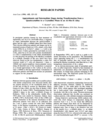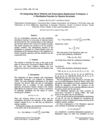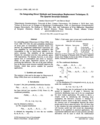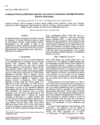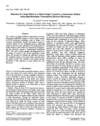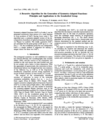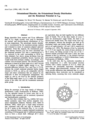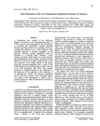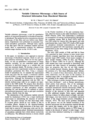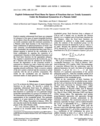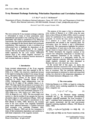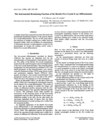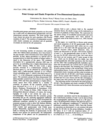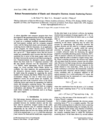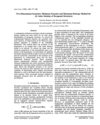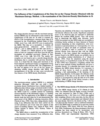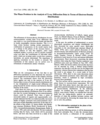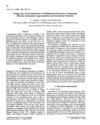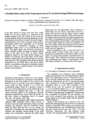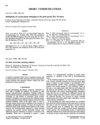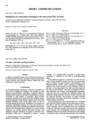issue contents
March 1996 issue

Cover illustration: Indicatrix of the inverse of Young's modulus for ADP, a tetragonal crystal. Courtesy of A. Authier, Laboratoire de Minéralogie-Cristallographie, Université Pierre et Marie Curie, Paris, France.
research papers
The transformation from a quasicrystalline to a crystalline Al–Mn–Si phase is described in terms of two complementary rhombohedral elements with edges along threefold axes in the icosahedron.
For two isomorphous structures, the joint probability distribution function of seven pairs of structure factors is derived, from which quartets may be estimated.
Formulas estimating quartet phases are provided in the absence of prior information and when the heavy-atom structure is known.
An empirical method is proposed for correcting the distortion of electron diffraction intensity caused by Ewald sphere, crystal bend, dynamical scattering etc. The method is based on the combination of electron diffraction and high-resolution electron microscopy.
The contrast of high-resolution transmission electron-micro- scope images and subtracted images are discussed by changing the noise level to examine the possibility for observation and identification of point defects with weak contrast.
A product of spherical harmonic functions can be resolved algebraically into a sum of single functions. This theorem is used to calculate high-order symmetry-adapted functions by a recursive algorithm.
The anisotropic density distribution and the rotational potential V(ω) is determined from neutron and X-ray diffraction data of C60 single crystals at 295K. V(ω) exhibits two sets of minima, which are fixed by the intrinsic geometry of the Euler-angle space.
Download citation


Download citation


Maximum-entropy reconstruction combined with a preliminary phasing of the absolute values of the observed structure factors by a crystal structure analysis provides for direct observation of the density of ammonia molecules indicating almost free rotation at 295K as well as at 30K.
All types of thermodynamically stable (Lifshitz) ordered structures arising from the disordered state of binary solid solutions with a hexagonal crystal lattice are established.
A systematic and reducible slow time variation of the diffracted intensities by the incommensurate phase of thiourea at 170K has been detected. The observed kinetic process can be quantitatively explained in terms of a slow relaxation of the soliton density, the structural modulation evolving towards a more sinusoidal regime.
Speckle statistics in transmission electron microscopy hollow- cone dark-field images provide evidence for medium-range order in annealed amorphous Ge films
Explicit complete orthonormal fixed bases are computed for subspaces of the space of square-integrable functions on the sphere where the subspaces contain functions that are totally symmetric under the rotational symmetries of a Platonic solid. The case of the icosahedron is important for structural studies of spherical viruses.
The X-ray resonant exchange scattering cross section is reformulated to highlight the contribution of the individual components of the magnetic moment. Static correlation functions are also derived.
An analytical description has been given for the instrumental broadening function of the Bartels diffractometer. This result allows determination of specimen rocking-curve widths from measured widths.
Possible point groups and elastic properties are discussed for a solid with two-dimensional quasi-periodic and one-dimensional periodic structure.
A robust algorithm has been developed and applied for parameterization of elastic and absorptive electron atomic scattering factors.
A combination of the n-dimensional symmetry minimum function with the maximum-entropy method for ab initio solution of decagonal structures is derived and two structure solutions are presented.
In order to examine the influence of the completeness of the data set on the charge densities derived with the maximum-entropy method (MEM), the structure-factor data for Si measured by the Pendellösung method is reanalysed by the MEM. It is found that the fine features in the previous MEM charge density of Si are non-physical artificial modulations caused by the failure of the MEM to extrapolate over the gap of missing data in the case of an incomplete set and that the maxima at the bond midpoint are exaggerated artificially owing to the incompleteness of the data set used for the MEM.
An explanation of why multipole refinements of electron-density distributions may lead to ambiguous or even meaningless results for non-centrosymmetric crystal structures is given. Specific examples show how applying constraints on the density models may improve this situation.
A kinematical expression is proposed to describe X-ray interference phenomena in the symmetric Bragg case from multi- lamina structures. The formalism is able to represent any desired sequence of crystalline and non-diffracting layers and hence can be applied to a variety of experimental situations. Comparison is made with experimental rocking curves obtained from implanted silicon with embedded amorphous layers.
The real state of the unusual spatial oscillation of Moiré fringes on the beam path out of a crystal is investigated with such experimental data as moiré topographs, intensity profiles, plots of the positions and directions of oscillating fringes, and a map of the oscillation amplitude over the whole field of the moiré pattern.
short communications
Erratum to International Tables for Crystallography, Vol. A, Table 10.2.2. The multiplicity of 00l or 00-l in the point group -4m2 is 2.
A method is presented which, given a molecular structure and an intermolecular force field, can predict observed polymorphic crystal structures and molecular clusters without any prior assumption of space symmetry.


 journal menu
journal menu








